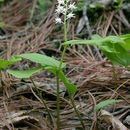More info for the terms:
cover,
density,
duff,
forest,
frequency,
fresh,
fuel,
litter,
seed,
severity,
wildfireCanada mayflower recovers slowly after fire [
17,
70]. Its
recovery rate may be variable due to the severity of burning or to
successive annual fires. Canada mayflower can be one of the
first species reported on a fresh burn [
124]. In a boreal mixed wood in
New Brunswick, it had widely variable responses during different seasons
of burning (spring, summer, or fall); therefore, averaged responses
among seasons was similar [
45]. In western Maine following a severe
fire where the organic soil was consumed, surviving wild
lily-of-the-valley sprouted after 1 month [
109]. However, it occurred
infrequently 2 years after a severe summer burn in which all the litter
and humus were destroyed and the mineral soil was exposed [
82]. In a
jack pine stand in northeastern Minnesota under various silvicultural
and prescribed burning treatments, there was a 20 percent decrease in
Canada mayflower 1 year following prescribed burning when
temperatures were less than 900 degrees Fahrenheit (482 deg C). Its
frequency decreased by 70 percent where temperatures mostly exceeded 900
degrees Fahrenheit (482 deg C) [
1]. There was a significant (p less than 0.05)
decrease in Canada mayflower biomass 2 years after a winter
clearcut and summer prescribed burning in northern Minnesota [
94].
Canada mayflower took 4 to 10 years to seed in from nearby areas
following prescribed fires on clearcuts seeded with jack pine [
18,
19].
Soil samples were taken from burned and unburned areas 3 years after a
fire in an old-growth red pine (Pinus resinosa) stand. Wild
lily-of-the-valley germinated only in soil from the unburned area [
4].
It was less frequent in open, burned areas than in unburned areas in
oak-pine woods [
13].
Following two successive annual, low-severity fires where the duff was
not consumed, Canada mayflower remained a dominant species with
increases in relative densities or frequencies at postfire years 1 to 3
[
83,
86,
91,
107]. It decreased in frequency from pretreatment levels of
42 percent down to 1 percent following logging with 2 successive years
of prescribed burning [
55]. In cutover areas aged 2 to 40 years since
fire, it had only 0 to 2 percent cover [
83]. Following prescribed
spring fires in boreal mixed woods, Canada mayflower frequency
declined from 40 to 16 percent. Its frequency further declined to 8
percent following another fire 6 years later on this area [
79].
Canada mayflower had lower frequencies (53 and 57 percent) than
the control (97 percent) 11 and 14 years after fires in mixed
conifer-hardwoods in northeastern Minnesota [
70]. It was one of the
most abundant species present 13 years following a severe wildfire in
mixed conifer stand in Minnesota and Ontario [
2]. In different burns
aged 9 to 50 years in Ontario, Canada mayflower had the highest
density on burns aged 25, 29, or 50 years [
102,
110]. At postfire year
33, it had similar frequencies (25 to 33 percent) and cover (1 to 2
percent) in four different forest communities of aspen-birch, birch,
jack pine-birch, and jack pine [
90]. In moist mixed woods in North
Dakota, its relative cover 80 years following fire was not different
from unburned areas [
95]. Fuel loadings were variable in fire-prone
forest stands in Michigan where Canada mayflower was a typical
understory species; it was present in low frequency (0.3 percent) 84
years following fire [
79].
There was no significant (p>0.05) difference in the occurrence of wild
lily-of-the-valley under five shade treatments (0 to 100 percent shade)
following a low-severity prescribed spring fire [
57].

